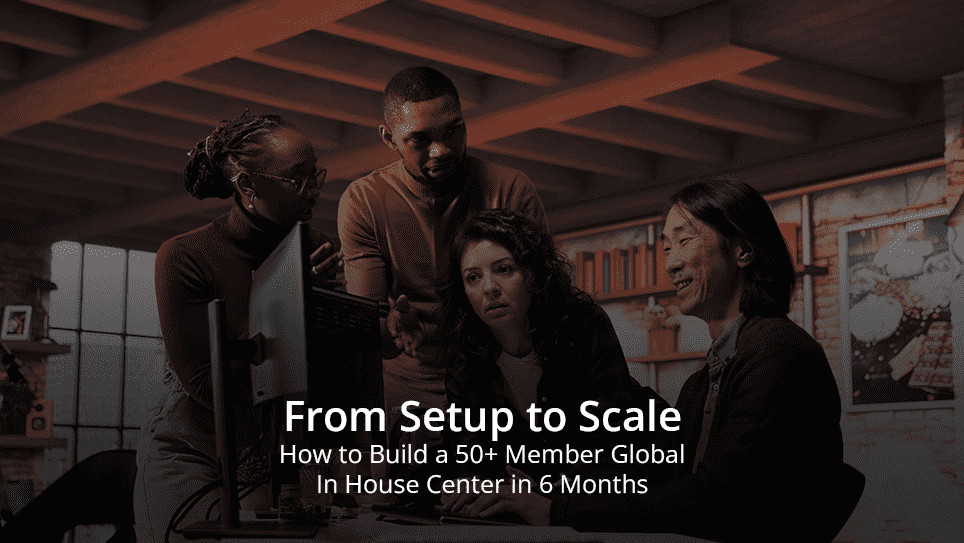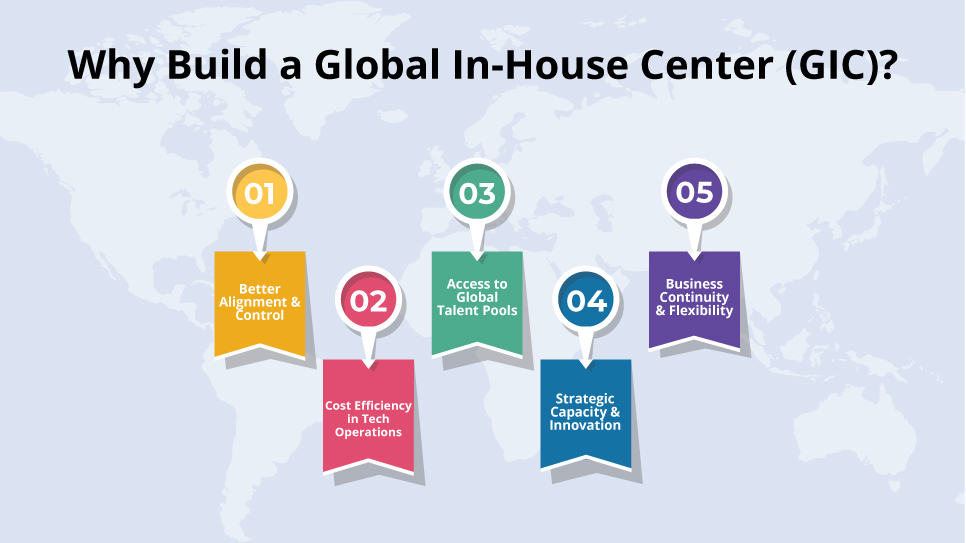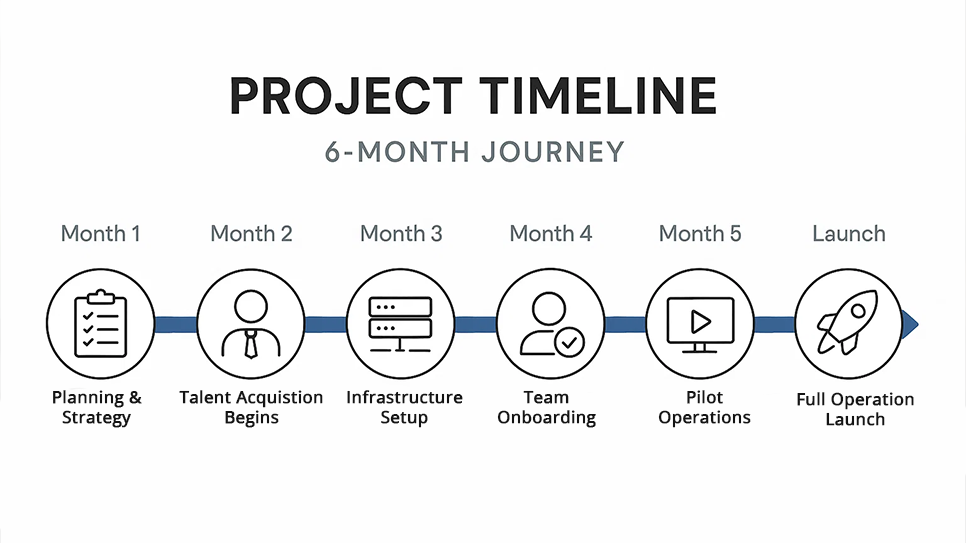From Setup to Scale: How to Build a 50+ Member Global In‑House Center in 6 Months

Launching a Global In-house Center (GIC), an offshore development center wholly owned by your company, has become a strategic move for enterprises seeking to expand their tech capacity and achieve cost efficiency in tech operations. But building a 50+ member GIC from scratch in just 6 months is an ambitious undertaking. It requires a clear GIC setup strategy, rapid hiring of dedicated engineering teams, and meticulous planning from day one.
Imagine: You’re a CTO or tech leader at a growing enterprise. You need to build a global tech team to accelerate R&D and custom enterprise application development, and you’re eyeing talent-rich hubs overseas. Rather than outsourcing key projects to third-party vendors, you decide to build a Global In-house Center, essentially your dedicated engineering teams operating as an extension of your company. This blog will guide you through the process of transitioning from an initial setup to a 50+ member GIC within 6 months, covering everything from legal setup to rapid team scaling.
In this blog, you’ll learn:
- Why choose a GIC? Key benefits of a Global In-house Center vs. traditional software outsourcing services, from cost savings to strategic control.
- GIC Setup Strategy & Planning: How to define your GIC setup strategy, pick the right location, and handle legal/infrastructure setup quickly.
- Rapid Team Building: Effective tactics to recruit and onboard 50+ skilled engineers fast, and how to build a global tech team aligned with your company culture.
- Scaling and Operations: Best practices for enterprise team scaling, including managing processes, ensuring quality, and embedding your company’s values (even your latest generative AI strategy) across the new center.
- Real-World Insights: Examples of companies that rapidly built offshore centers, illustrating what worked in practice and how to avoid common pitfalls.
This setup-to-scale playbook is geared towards tech executives and founders who want a step-by-step guide to launch an offshore GIC efficiently. Let’s dive into the journey from zero to fifty (and beyond) in six months.
Why Build a Global In-House Center (GIC)?

Before jumping into the “how,” it’s crucial to understand the “why.” A Global In-house Center is essentially an offshore development center owned and operated by your company, rather than a third-party vendor. GICs started as back-office support hubs, but today they drive core innovation, product development, and even advanced initiatives like AI research for their parent companies. Here are key reasons enterprises opt for the GIC model:
- Better Alignment & Control: Unlike outsourcing to vendors, a GIC gives you dedicated engineering teams that work exclusively for your business, preserving your domain knowledge and IP. Teams in a GIC are part of your organization; they follow your processes, security standards, and product roadmap closely, which is ideal for sensitive projects like custom enterprise application development or proprietary R&D.
- Cost Efficiency in Tech Operations: Cost savings are a big draw. By tapping into talent-rich, lower-cost locations, companies typically see a 30-40% cost advantage in operating expenses versus Western locations. You reduce costs on salaries, infrastructure, and overhead while maintaining quality. These savings contribute directly to cost efficiency in tech operations, freeing budget for innovation.
- Access to Global Talent Pools: Markets like India, Eastern Europe, or Latin America offer vast pools of engineers and specialists. A GIC lets you build a global tech team that taps into this talent diversity. Need experts in AI/ML, mobile, or cloud? Chances are, you’ll find them readily available in these hubs. Moreover, GICs can evolve into Centers of Excellence in areas like data analytics, cloud, or even emerging fields like generative AI strategy for the enterprise, giving you a competitive edge with specialized skills.
- Strategic Capacity & Innovation: GICs aren’t just about cost; they enable enterprise team scaling aligned with strategic goals. Because the team is in-house, you can pivot them to new priorities quickly or have them focus on innovation rather than just routine tasks. Many companies use their GIC to drive digital transformation initiatives.
- Business Continuity & Flexibility: With a globally distributed team, your operations become more resilient. A GIC can operate in a different time zone, providing 24/7 development cycles or support. It also gives flexibility to scale teams up or down as needed without the constraints of vendor contracts.
In short, a GIC allows you to combine the focus and cohesion of an in-house team with the talent access and cost benefits of offshoring. That said, setting up a GIC requires upfront effort, which is where a solid plan comes in. Let’s look at how to craft a winning GIC setup strategy.
Planning Your GIC Setup Strategy (Month 0-1)
Every successful build-out starts with a plan. Planning is what will keep your 6-month timeline on track. At this stage, you’ll define the scope and foundation of your GIC setup strategy:
- Define Goals and Scope: Clarify what functions your GIC will serve. Will it handle core product development, QA, customer support, or act as an R&D lab? Defining this helps determine the skills you need and how to organize your teams. For instance, if the GIC will focus on custom enterprise application development for internal tools, you’ll plan for more software engineers and business analysts; if it’s a research hub for your generative AI strategy, you may prioritize AI/ML researchers and data scientists.
- Choose the Location Wisely: Selecting the right geography and city is critical. Key considerations include talent availability, cost of operations, business environment, and any time-zone alignment needs. Traditional tech hubs like Bangalore, Hyderabad, or Warsaw offer deep talent pools, while emerging hubs (e.g., Vietnam, Latin America, or new Indian hubs like GIFT City) might offer tax incentives and lower competition for talent. Do market research on labor costs, language skills, and attrition rates in each locale.
- Legal Entity and Compliance Setup: To operate in a foreign country, you’ll need to register a legal entity (such as a private limited company or branch office). Kick off this process early, as paperwork and approvals can take weeks. Engage legal counsel to navigate local regulations, corporate laws, and any Special Economic Zone (SEZ) benefits. Ensuring compliance from day one (tax registrations, labor law adherence, IP protection) will save headaches later.
- Budgeting and Timeline: Outline the budget for the GIC’s first year, including facilities, salaries, equipment, and any vendor support (e.g., recruitment agencies or IT service providers). A well-planned budget ensures you can offer competitive packages to attract top talent.
Crafting a robust strategy upfront is like laying the foundation for a building. It aligns stakeholders on the vision and reduces the risk of delays. With goals set and a roadmap in hand, you’re ready to start the actual setup of the offshore development center.
Setting Up the Offshore Development Center (Month 1-2)
With a strategy defined, the next phase is getting the offshore development center operational. This involves setting up the physical (or virtual) workspace and core infrastructure that your new team will need.
- Office Space and Facilities: Decide whether to start in a co-working/serviced office or lease a permanent office. For speed, many opt for plug-and-play offices in tech parks or co-working spaces; you can secure space in days, not months. Ensure the location is accessible to talent and has room to accommodate growth beyond 50 people if you plan further expansion.
- IT Infrastructure and Security: A GIC dealing with core development needs a robust IT setup. Configure development and staging environments, equip employees with required hardware, and establish network security. Use cloud infrastructure for agility, for instance, cloud-based code repositories and CI/CD pipelines accessible globally.
- Hiring Core Leadership & HR/Admin: To hit 50+ hires quickly, get a local leadership team in place early. This often includes a site manager or GIC director, an HR lead, and maybe a finance/administrative officer. These leaders will be your boots-on-the-ground to drive recruiting and handle day-to-day operations.
- Leverage Local Incentives: Many regions offer incentives for setting up new technology centers, from tax holidays to grants. For example, India’s SEZs can provide 100% tax exemptions on export income for the first few years.
By the end of Month 2, aim to have the entity operational, an office ready (even if temporary), basic infrastructure in place, and a small nucleus of leaders/administrators hired. Your Global In-house Center now exists on paper and in facilities; next comes the most important part: filling it with the right talent.
Recruiting and Building a Global Tech Team (Month 2-5)
Building a 50+ member team in a few short months is a hustle, but with the groundwork laid, you can now build a global tech team at full throttle. This phase is all about talent acquisition and onboarding at scale, without compromising on quality.
- Aggressive Recruitment Drive: Start recruiting efforts as soon as your GIC is formally set up. Utilize multiple channels: specialist recruitment agencies, job portals, LinkedIn outreach, campus hiring for juniors, and employee referrals. Make sure your job postings highlight the exciting opportunity of joining an “innovation center” of a foreign company; this can attract ambitious talent.
- Hiring for Key Roles and Balance: Aim for a mix of senior and junior hires. Early on, bring in a few senior engineers or tech leads who can act as team anchors and mentors for the influx of juniors later. These seniors ensure quality doesn’t drop when quantity rises. If you’re building multiple teams, hire the team leads or architects first. They can even help interview subsequent candidates.
- Fast-Track Onboarding: With people accepting offers quickly, you need a tight onboarding process. Prep as much in advance as possible, have IT accounts, email addresses, equipment, and seating ready for each new joiner’s first day. Create an “onboarding bootcamp” that every batch of new hires goes through: introduction to company culture, the product or project they’ll work on, development practices, and communication tools.
- Building Culture from Day 1: One challenge of rapid scaling is maintaining a unified culture. Make sure the values and work ethic of your HQ transfer to the GIC. Simple ways to do this include regular all-hands video calls, flying in HQ engineers or managers to spend a week with the new team, and celebrating milestones of the GIC.
Throughout this recruitment wave, keep a close eye on quality and fit. It’s tempting to cut corners to meet headcount by Month 6, but a bad hire can set you back. Use structured interviews, technical tests, and cultural fit assessments.
Scaling Up: Managing and Integrating Your 50+ Member GIC (Month 5-6 and beyond)
As you approach the 50-member mark, the focus shifts from pure hiring to scaling operations smoothly. This is where you solidify processes, ensure performance, and integrate the GIC tightly with your global organization. It’s also the moment to plan for life after the 6-month sprint: how will the GIC continue to deliver value and possibly grow further?
- Process and Delivery Management: By now, you likely have several project teams in the GIC. Implement robust project management practices to keep work on track across time zones. It’s crucial that the offshore teams feel like an extension of the onshore teams, not siloed contractors.
- Quality Assurance and Knowledge Sharing: With fast growth, ensure that quality controls are in place. Set up code review practices, automated testing, and continuous integration pipelines from the get-go, so that even as team size grows, code quality and product reliability remain high.
- Cultural Integration and Team Morale: At ~50 people, you should have a solid management layer in your GIC. Work with them to maintain the company culture. Small things make a big difference: celebrate local holidays and include the GIC in global company events. If feasible, organize exchange visits, have a few GIC members visit HQ for a couple of weeks, and vice versa, to foster personal connections.
- Strategic Alignment and Next Steps: Now that your GIC is up and running with 50+ people, align its plans with your company’s strategy. Maybe this center can take on new projects or even whole product lines. By giving the GIC a strategic charter, you ensure its long-term relevance and support from top management.
By the end of Month 6, congratulations are in order. You’ve built a fully functional Global In-house Center with over 50 talented individuals, essentially creating a new branch of your enterprise.

For example, the timeline might show:
- Month 1: Planning & Strategy
- Month 2: Talent acquisition begins
- Month 3: Infrastructure setup
- Month 4: Team onboarding
- Month 5: Pilot operations
- Month 6: Full operations launch
Conclusion: Your GIC Journey from 0 to 50 and Beyond
Setting up a 50+ member Global In-house Center in six months takes more than speed; it takes focus, structure, and the right partners.
At FX31 Labs, we help companies build and scale offshore development centers with dedicated engineering teams that align with business goals from day one. From custom enterprise application development to generative AI strategy, we bring hands-on expertise across the stack.
And for fast, intelligent hiring, Talent31 simplifies how you find and onboard top global tech talent, built for teams scaling at pace.
Ready to turn your GIC vision into execution?
Let’s build it right.
FAQs
1. What is a Global In-House Center (GIC)?
A Global In-House Center (GIC) is a company-owned offshore development hub where teams work exclusively for the parent company. Unlike outsourcing, GICs offer tighter control, better alignment with internal processes, and long-term cost efficiency.
2. How long does it take to set up a GIC?
With the right GIC setup strategy and execution partners, you can set up a fully operational 50+ member GIC in 6 months. This includes legal setup, infrastructure, hiring, onboarding, and scaling.
3. What are the benefits of building a GIC instead of outsourcing?
Building a GIC gives you direct control over your teams, ensures better IP protection, aligns operations with your company culture, and enables you to scale strategically. It’s ideal for companies focused on custom enterprise application development or R&D.
4. What kind of tech roles should a GIC include?
GICs often include full-stack developers, data engineers, cloud specialists, QA leads, DevOps, and AI/ML teams depending on your business goals. If you’re building enterprise-grade platforms or AI-driven tools, these roles become critical.
5. What are the biggest challenges in setting up a GIC?
Common challenges include legal compliance, hiring quality at speed, aligning remote teams with HQ processes, and maintaining culture. Having the right execution partner, like FX31 Labs, can reduce these risks significantly.
